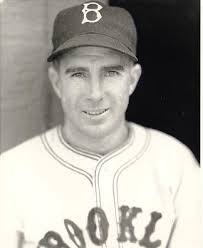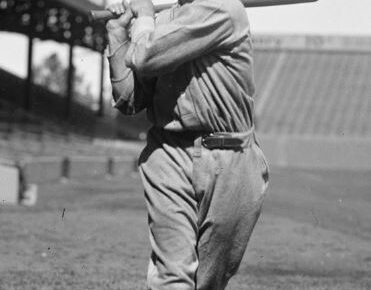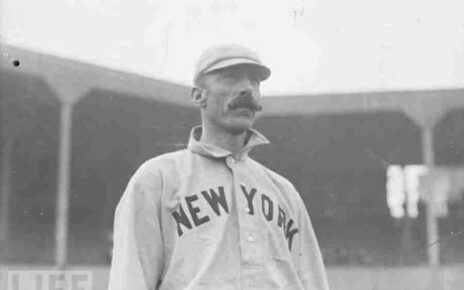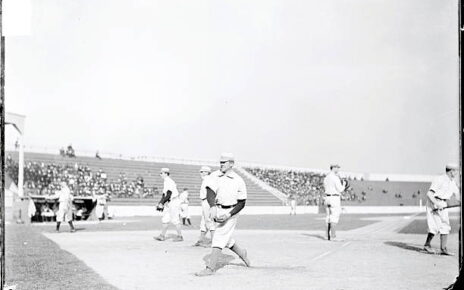If not for a 1922 demotion to the A-level New Haven ball club (As a reminder, I don’t use racist team names on this site so if you want to know the actual name you will need to look it up yourself) Johnny Cooney may never have spread his two-way wings. Though he spent his amateur life as a pitcher and a hitter the Boston National League club (see the aforementioned notice) signed him as a pitcher.
After a less than stellar rookie season, Cooney split his 1922 season between Boston and New Haven. Cooney pitched in 27 games and played the field, position unknown, in 22 games. Cooney was no great shakes with the bat, slashing .236/Unknown/.350 in 49 plate appearances, though we’ll chalk this up as an incomplete season as his major league results are clearly missing some data. In his 220 innings on the mound, Cooney dominated. A 1.96 ERA, 0.995 WHIP, and 187 ERA+ in his 4 major league games. Though his major league time was limited Cooney amassed 0.5 rWAR and had positioned himself as a pitcher Boston could count on, but about that two-way attempt…
1923 saw Cooney keep playing two-ways, and everything seemed to be coming up aces for the Cranston native. In 2 games in left field, 8 in center, 1 in right field and 1 at first base he slashed .379/.414/.394 for an OPS+ of 119 in 73 plate appearances. When hurling the ball Cooney kept his ledger in the black. Across 98 innings in 23 games he spun a 3.31 ERA, 3.63 FIP, 1.163 WHIP, and 120 ERA+. His combined 3.0 rWAR made Cooney a player Boston should have been able to count on moving forward.
When 1924 rolled around Cooney regressed somewhat. He took the field for 1 game at first base, 15 in center, 1 in right, and 34 on the mound. Cooney again excelled on the mound, posting a 1.249 WHIP, 3.48 FIP, and 3.18 ERA in 181.0 innings. With the bat, Cooney took a few steps back. His .254/.302/.285 slash line was the basis for an ugly 61 OPS+. Still, a total of 3.8 rWAR meant Cooney logged another great season, even if almost all his value came from his pitching.
After not taking the field enough to qualify as a two-way player in 1925 Cooney was back at in 1926 with 19 games on the mound, 31 at first base, and 1 in right field. Cooney produced an average 103 OPS+ thanks to his .302/.367/.357 slash line in 147 plate appearances. He also upped his speed game by swiping 6 bags. On the mound, Cooney struggled, his ERA+ of 88 was his first below-average season as a pitcher since his rookie campaign.
An arm injury sidelined Cooney for most of 1927 and in 1928 Cooney didn’t play the field enough to merit two-way status. 1929 was pretty much a lost year for Cooney. His 14 games at pitcher, 4 in left field, 11 in center, and 1 in right qualified him for two-way status once again. However, the magic he once had on both sides of the ball was now gone. In his worst season as a two-way player, Cooney managed an rWAR of 0.6 as neither his OPS+ or ERA+ managed to break the 100 mark.
From that point on Cooney’s days as a major league two-way player were over. But, in 1931 he found himself sold to the Toledo Mud Hens of the American Association and he resumed his two-way status. He pitched in 25 games that year while also playing 64 games in the outfield. Cooney was effective on both sides of the baseball once again. He slashed .289/Unknown/.383 in 342 at-bats while posting an ERA of 2.49 and a WHIP of 1.253 in 166.0 innings pitched.
1932 with the AA’s Indianapolis club was the end of the road for Cooney as a two-way player at any level and it’s easy to see why. In 32 games as a pitcher, the left-handed hurler still had a respectable 3.52 ERA, but his WHIP ballooned to 1.408 over 174.0 innings. The right-handed slugger slashed .291/Unknown/.343 in 175 at-bats. He didn’t exactly set the world on fire with the bat, but Cooney had shown over the past few seasons that if he had a future in baseball it was with a bat on his shoulder as opposed to a rosin bag in his hand.
The transition to a full-time hitter was exactly what Cooney needed. His last innings as a pitcher were a scant 20.0 innings in 1933, followed by 10 years as a serviceable minor league and then major league hitter. Cooney is an interesting two-way case study, for a few years he was very successful on both sides of the ball. Succeeding as a two-way player is hard though, like really hard and that someone as good both ways as Cooney could falter so easily just highlights that fact.
Lead photo courtesy of Unknown – Unknown




